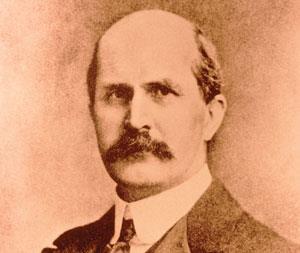An isotopic anniversary, climate scepticism and the origins of Bragg’s Law.
Diffraction detail
From Michael Baldwin
Andrea Sella’s article ‘The Braggs’ spectrometer’ notes William Lawrence Bragg’s equation n?= 2dsin?, published in 1912.
I was surprised several years ago when I read Solar physics by J Norman Lockyer, published in 1874. The book contains the equation sind = n?/d, giving the relationship between the line spacing in a diffraction grating and the angle of the diffracted light from the perpendicular. It is essentially the same equation as that of Bragg, the main difference being that the Bragg equation relates to the angles at which monochromatic x-rays are reflected by the successive layers of atoms below the surface, while the other equation relates to diffraction of transmitted light by lines drawn on the grating at right angles to the direction of the incident beam.
The equation quoted by Lockyer supports his discussion of the work of Anders Jonas Ångstrom, who mapped the solar spectrum using a diffraction grating which, for the first time, enabled wavelengths to be assigned to spectral bands. At the time of Lockyer there were two scales in use for spectra. The original one was that of Gustav Kirchhoff who mapped the solar spectrum using prism spectrometers. His spectral line numbers were based on an arbitrary scale, though his map was very detailed. The second was that of Ångstrom, with actual wavelengths. Lockyer used both scales. Indeed, he used the Kirchhoff scale to describe his mysterious green spectral line in the spectrum of the solar corona, first seen in June 1869 during an eclipse. It was later identified as an emission of the previously undiscovered element helium.
So, when giving Bragg the credit for applying his equation to crystal structures, spare a thought for Ångstrom who was using an almost identical equation about 40 years before.
M K Baldwin FRSC
Kent, UK
Power of plutonium
From Brian Price
Mark Peplow’s article ‘A century of isotopes’ highlights the invaluable role played by radioisotopes in science and medicine. Unfortunately, the article perpetuates the myth that Calder Hall was a purely commercial nuclear power station.
In fact, it was primarily built to manufacture plutonium for military purposes, with electricity as a valuable by-product. The portrayal of the plant as a purely civil one, by the UK Atomic Energy Authority, was not strictly correct – it wasn’t just the turbines that were spinning!
B Price CChem MRSC
Weston-super-Mare, UK
Uncharted isles
From Mark Foreman
David Jones’ article ‘Cosmic chemistry’ attracted my attention.
As someone in a chemistry unit where many people work on elements with more protons than uranium, I would like to comment that the islands of stability are more than a theoretical idea. An island of stability exists around thorium, uranium, plutonium and curium. Some isotopes of plutonium and curium have very long half lives (244Pu 80 million years and 247Cm 15.6 million years), while the longest lived nuclide of radon is 222Rn (half life 3.8 days).
A sea of short lived nuclides exists between the mainland of stable elements (lead is ‘Land’s End’) and the island which starts at radium. That island ends around about einsteinium (252Es half life 1.3 years), but it is possible that at least one more island exists.
M Foreman CChem MRSC
Nuclear Chemistry, Chalmers University of Technology, Sweden
Sceptical chemist
From John Leisten
Climatology is favoured rather uncritically by governments, the UN and the media, so it would not be surprising if the majority of busy chemists accepted its ‘95% certain’ predictions.
Yet as a retired academic with time to browse I have read many well-argued doubts about the climatologists’ conclusions. The criticisms are occasionally rebutted, but more often swamped by references to a consensus, or by attempts to discredit the critics: witness Philip Ball’s reference to ‘ornery’ chemists.
Ball describes climate scepticism differently in different parts of his article, but for me it is simply a lack of trust in climatology. To give scepticism a purpose, I would question whether the clamour of a science so much more speculative than chemistry should be allowed to further weaken the already stretched western economies.
There is a curious unwillingness to distinguish between the sciences. With its cover-all phrase ‘according to scientists’, the media will predict a solar eclipse and the submersion of low-lying islands without any hint of the credibility gulf between the two. And the 3% of sceptical climatologists mentioned by Ball becomes 3% of scientists when it reaches the general public. Beyond the climate debate, this failure threatens the public perception of chemistry and other hard sciences, for without informed appraisals of the various sciences the public is likely to tar them all with the same brush. Expressed scepticism where merited is better than polite silence.
J A Leisten CChem FRSC
Queensland, Australia
Fracking concerns
From Barrie Skelcher
With regard to fracking, a lot of work has been done on the question of ground water pollution. However, there are at least a couple of other aspects that should be considered and I have not heard of them being investigated.
Gas is a compressible material and is being replaced by water, which is not. Gas is chemically a reducing agent, the water that replaces it is an oxidising agent. In the short term these differences are unlikely to have any effect, but what about the long term as underground pressure builds?
B Skelcher CChem MRSC
Suffolk, UK











No comments yet